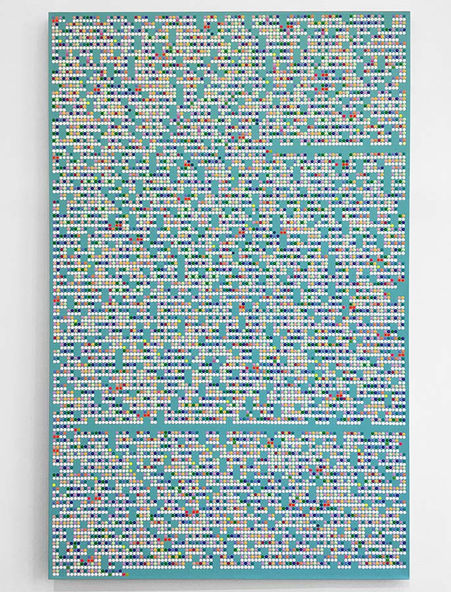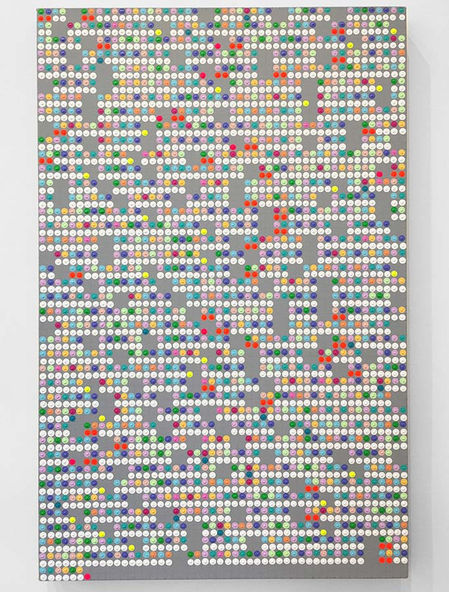Author’s Translations features the works of two UK-based artists and their response to the idea of translation. Both artists’ works examine whether different passages of text (whether different by linguistic style or language) can have the same ultimate meaning.
Although the artists follow the same process, translating the original edition of a text in order to explore the possibilities and boundaries of expression and information, their technique is totally different. On the one hand, Josh Rowell creates paintings as new forms of visual text, and on the other, Paula Morison uses one of the most common online translation websites to explore her ideas.
Josh Rowell is a British artist who focuses on technological upgrades that shape our contemporary lives, communicating our increasingly mediated human interactions within the confines of visual art. The artist balances analogue techniques with the instantaneous nature of the digital age. This juxtaposition produces a language that explores and reshapes information, and celebrates the hand-made in a time that is increasingly being enveloped by the virtual.
The artist creates a series of paintings that are coding systems for language; each one contains within them a body of text that can be taken from any source (book, magazine, script) and from any language. He then processes the information through a coding system of his own design. The system operates through colour, sequence and pattern, and ultimately the language becomes transformed into the painting. In each work there is the potential for it to be read, as it was in its original state, and, as it is in its altered state. Through making these works, Rowell wanted to explore what it means to reshape information, and think about alternative ways of seeing, or ‘reading’ the world around us. With language, spoken and written, as our primary means of communicating, it seemed a natural starting point for him to work with.
The series on display is called Exercises in Styleand presents a different reading of Raymond Queneau’s book (1947). In the book Exercises in Style, the same incident is played over and over again, ninety-nine times, in different ways, and is told in different voices, different points of view. Like that, while Queneau is showing the potential limitless of language and pushes the boundaries of linguistic meaning, Rowell is expanding on this concept to create his works. The artist develops a series of six different paintings – each one equivalent to one of the following languages: English, Italian, French, German and Spanish. This sequence aims to construct a further representation of the original story, one equally as valid as any other, adopting a new form of visual language. In the same way that Queneau’s 99 stories can be seen simultaneously as both repetitions and unique passages, the paintings themselves initially appear as copies of each other until on closer inspection each one can be seen and understood as unique. Thus, the idea that ‘the newness of meaning is prescribed in each repetition’, employed by the French philosopher Giles Deleuze in his book ‘Difference and Repetition’, is fundamental to the artist’s creative thinking. As Rowell supports, the subtleties between the different linguistic styles are mimicking the subtle differences between the paintings.
Paula Morison is a British conceptual artist who works in a variety of media. Her practice is focused on how we, as humans, try to order the world around us. She is fascinated with data, numbers, dates and time. However, she is also interested in the poetic and the whimsical, chance and coincidence, and mixes these differing concerns together to various degrees in her work. Translating, in the widest sense of the word, is a process she often employs; translating numbers into colours, whimsical ideas into seemingly reliable data; creative processes into an ordered administrative structure.
In this case, the artist has used translation very literally. In the featured work, Babel,she has taken the story of the Tower of Babel from the Bible (Genesis 11:1-9) and translated it using Google Translate through the official languages of the twelve countries in the world with the highest number of Christians. As this tool is not totally accurate, this process skews and distorts the text and changes the meaning of it as it moves from language to language.The story of the Tower of Babel can be interpreted in many ways, however, the artist was interested in the possible interpretation of it as a story about God punishing the people of the world because they spoke the same language and therefore could cooperate too well; that by having one common language they became a threat to God. The fact that in this interpretation God punished cooperation and communication seems incongruous with contemporary solutions for problems in the world.
The original text was taken from the King James Version of the Holy Bible. This is the most popular translation of the Holy Bible used in the United States of America – the country in the world with the highest number of Christians. According to the data that the artist used, after the USA the next eleven countries with the highest number of Christians are Brazil, Mexico, Russia, the Philippines, Nigeria, China, the Democratic Republic of the Congo, Germany, Ethiopia, Italy and the United Kingdom.
The Bible in the beginning was obviously not written in English and has been translated and copied out many times since it was written. In Morison’s project, the viewer can see the changes the text undergoes as it is translated through the different languages. This can be seen to mirror the many hidden translations this text has already undergone before it was published, and to highlight the fact that what the user is faced with as an original may be similarly flawed due to centuries of editing, translation and interpretation.
This translation was recorded on 23rd June 2016 so this work also provides a snapshot of Google's translation algorithms at that time.
Josh Rowell is a UK-born artist who graduated from Kingston Art School in 2013, where he received a first class BFA with honours. Following a course in Art Criticism at Central Saint Martin’s College, Rowell returned to Kingston Art School for an MFA in 2015, where he was awarded a first- class distinction. His works have been exhibited in London, New York, Miami, Seattle, Basel, Hong Kong and Mexico and are part of public collections including the Uffizi Gallery in Florence, the Gregorian Foundation in Washington, London Kingston University's contemporary art collection, and the Matilda collection in San Miguel De Allende. In 2017/18 he had his first museum exhibition at the Palacio Nacional de Guatemala. Rowell won the Public Choice award at the VIA Arts Prize 2017, and was included in Future Now, the yearly publication by Aesthetica listing the 100 most interesting emerging artists of the year. In 2019 he was selected for the Royal Academy Summer Exhibition, London. In February Rowell will have a solo booth at Salon Acme in Mexico City.
Paula Morison is a UK-born artist who graduated from University of Wales, Institute Cardiff in 2008 and Slade School of Fine Art, London in 2019. Her works have been exhibited in London, Paris, Manchester, Liverpool, Cardiff, Swansea and Gloucestershire. In 2018 Morison was selected for Bloomberg New Contemporaries which toured to South London Gallery, London and Liverpool School of Art & Design during the Liverpool Biennial. This same year she was also selected for the Red Mansion Art Prize, an exhibition of which was held at the Royal Academy in 2019.














